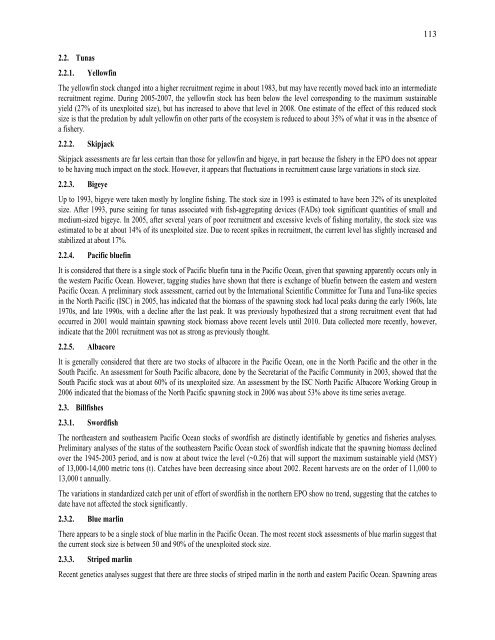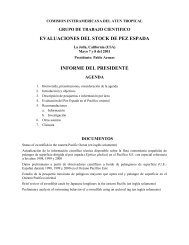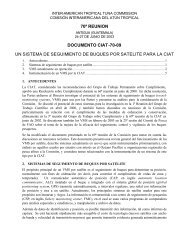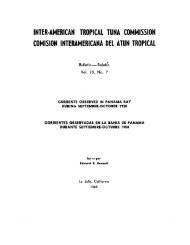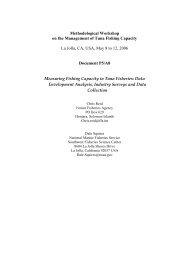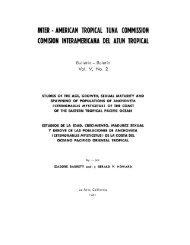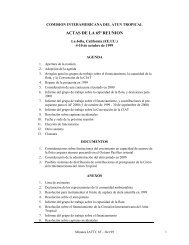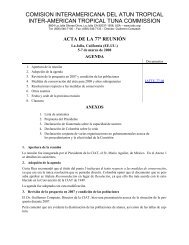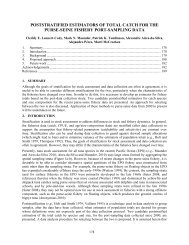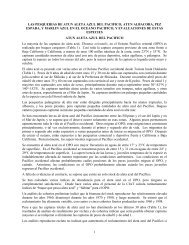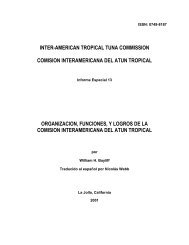112J. ECOSYSTEM CONSIDERATIONS1. Introduction..................................................................................................................................................................................... 1122. Impact of catches ............................................................................................................................................................................ 1123. Other ecosystem components......................................................................................................................................................... 1184. Trophic interactions........................................................................................................................................................................ 1195. Physical environment ..................................................................................................................................................................... 1216. Aggregate indicators....................................................................................................................................................................... 1227. Ecosystem modeling....................................................................................................................................................................... 1238. Actions by the IATTC and the AIDCP addressing ecosystem considerations ............................................................................. 1239. Future developments....................................................................................................................................................................... 1251. INTRODUCTIONThe FAO Code of Conduct for Responsible Fisheries provides that management of fisheries should ensure the conservation notonly of target species, but also of the other species belonging to the same ecosystem. In 2001, the Reykjavik Declaration onResponsible Fisheries in the Ecosystem elaborated this standard with a commitment to incorporate an ecosystem approach intofisheries management.The IATTC has taken account of ecosystem issues in many of its decisions, and this report on the offshore pelagic ecosystem of thetropical and subtropical Pacific Ocean, which is the habitat of tunas and billfishes, has been available since 2003 to assist in makingits management decisions. This section provides a coherent view, summarizing what is known about the direct impact of the fisheriesupon various species and species groups of the ecosystem, and reviews what is known about the environment and about otherspecies that are not directly impacted by the fisheries.This review does not suggest objectives for the incorporation of ecosystem considerations into the management of tuna or billfishfisheries, nor any new management measures. Rather, its prime purpose is to offer the Commission the opportunity to ensure thatecosystem considerations are part of its agenda.It is important to remember that the view that we have of the ecosystem is based on the recent past; we have almost no informationabout the ecosystem before exploitation began. Also, the environment is subject to change on a variety of time scales, including thewell-known El Niño fluctuations and more recently recognized longer-term changes, such as the Pacific Decadal Oscillation andother climate changes.In addition to reporting the catches of the principal species of tunas and billfishes, the staff has reported the bycatches of other speciesthat are normally discarded. In this section, data on these bycatches are presented in the context of the effect of the fishery onthe ecosystem. Unfortunately, while relatively good information is available for the tunas and billfishes, information for the entirefishery is not available. The information is comprehensive for large (carrying capacity greater than 363 metric tons) purse seinersthat carry observers under the Agreement on the International Dolphin Conservation Program (AIDCP), and information on retainedcatches is also reported for other purse seiners, pole-and-line vessels, and much of the longline fleet. Some information is availableon sharks that are retained by parts of the longline fleet. Information on bycatches and discards is also available for large purseseiners,and for some smaller ones. There is little information available on the bycatches and discards for other fishing vessels.2. IMPACT OF CATCHES2.1. Single-species assessmentsThis section provides a summary of current information on the effects of the tuna fisheries on the stocks of individual species in theeastern Pacific Ocean (EPO). It focuses on the current biomass of each stock considered, compared to what it might have been in theabsence of a fishery. The intention is to show how the fishery may have altered the components of the ecosystem, rather than thedetailed assessments, which can be found in other sections of this report and in other IATTC documents. The section below frequentlyrefers to comparisons with the estimated unexploited stock size. There are no direct measurements of the stock size beforethe fishery began, and, in any case, the stocks would have varied from year to year. In addition, the unexploited stock size may beinfluenced by predator and prey abundance, which is not included in the single-species analyses.
2.2. Tunas2.2.1. YellowfinThe yellowfin stock changed into a higher recruitment regime in about 1983, but may have recently moved back into an intermediaterecruitment regime. During 2005-2007, the yellowfin stock has been below the level corresponding to the maximum sustainableyield (27% of its unexploited size), but has increased to above that level in 2008. One estimate of the effect of this reduced stocksize is that the predation by adult yellowfin on other parts of the ecosystem is reduced to about 35% of what it was in the absence ofa fishery.2.2.2. SkipjackSkipjack assessments are far less certain than those for yellowfin and bigeye, in part because the fishery in the EPO does not appearto be having much impact on the stock. However, it appears that fluctuations in recruitment cause large variations in stock size.2.2.3. BigeyeUp to 1993, bigeye were taken mostly by longline fishing. The stock size in 1993 is estimated to have been 32% of its unexploitedsize. After 1993, purse seining for tunas associated with fish-aggregating devices (FADs) took significant quantities of small andmedium-sized bigeye. In 2005, after several years of poor recruitment and excessive levels of fishing mortality, the stock size wasestimated to be at about 14% of its unexploited size. Due to recent spikes in recruitment, the current level has slightly increased andstabilized at about 17%.2.2.4. Pacific bluefinIt is considered that there is a single stock of Pacific bluefin tuna in the Pacific Ocean, given that spawning apparently occurs only inthe western Pacific Ocean. However, tagging studies have shown that there is exchange of bluefin between the eastern and westernPacific Ocean. A preliminary stock assessment, carried out by the International Scientific Committee for Tuna and Tuna-like speciesin the North Pacific (ISC) in 2005, has indicated that the biomass of the spawning stock had local peaks during the early 1960s, late1970s, and late 1990s, with a decline after the last peak. It was previously hypothesized that a strong recruitment event that hadoccurred in 2001 would maintain spawning stock biomass above recent levels until 2010. Data collected more recently, however,indicate that the 2001 recruitment was not as strong as previously thought.2.2.5. AlbacoreIt is generally considered that there are two stocks of albacore in the Pacific Ocean, one in the North Pacific and the other in theSouth Pacific. An assessment for South Pacific albacore, done by the Secretariat of the Pacific Community in 2003, showed that theSouth Pacific stock was at about 60% of its unexploited size. An assessment by the ISC North Pacific Albacore Working Group in2006 indicated that the biomass of the North Pacific spawning stock in 2006 was about 53% above its time series average.2.3. Billfishes2.3.1. SwordfishThe northeastern and southeastern Pacific Ocean stocks of swordfish are distinctly identifiable by genetics and fisheries analyses.Preliminary analyses of the status of the southeastern Pacific Ocean stock of swordfish indicate that the spawning biomass declinedover the 1945-2003 period, and is now at about twice the level (~0.26) that will support the maximum sustainable yield (MSY)of 13,000-14,000 metric tons (t). Catches have been decreasing since about 2002. Recent harvests are on the order of 11,000 to13,000 t annually.The variations in standardized catch per unit of effort of swordfish in the northern EPO show no trend, suggesting that the catches todate have not affected the stock significantly.2.3.2. Blue marlinThere appears to be a single stock of blue marlin in the Pacific Ocean. The most recent stock assessments of blue marlin suggest thatthe current stock size is between 50 and 90% of the unexploited stock size.2.3.3. Striped marlinRecent genetics analyses suggest that there are three stocks of striped marlin in the north and eastern Pacific Ocean. Spawning areas113


